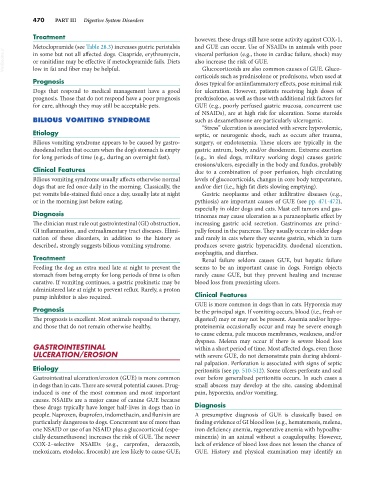Page 498 - Small Animal Internal Medicine, 6th Edition
P. 498
470 PART III Digestive System Disorders
Treatment however, these drugs still have some activity against COX-1,
Metoclopramide (see Table 28.3) increases gastric peristalsis and GUE can occur. Use of NSAIDs in animals with poor
VetBooks.ir in some but not all affected dogs. Cisapride, erythromycin, visceral perfusion (e.g., those in cardiac failure, shock) may
also increase the risk of GUE.
or ranitidine may be effective if metoclopramide fails. Diets
Glucocorticoids are also common causes of GUE. Gluco-
low in fat and fiber may be helpful.
corticoids such as prednisolone or prednisone, when used at
Prognosis doses typical for antiinflammatory effects, pose minimal risk
Dogs that respond to medical management have a good for ulceration. However, patients receiving high doses of
prognosis. Those that do not respond have a poor prognosis prednisolone, as well as those with additional risk factors for
for cure, although they may still be acceptable pets. GUE (e.g., poorly perfused gastric mucosa, concurrent use
of NSAIDs), are at high risk for ulceration. Some steroids
BILIOUS VOMITING SYNDROME such as dexamethasone are particularly ulcerogenic.
“Stress” ulceration is associated with severe hypovolemic,
Etiology septic, or neurogenic shock, such as occurs after trauma,
Bilious vomiting syndrome appears to be caused by gastro- surgery, or endotoxemia. These ulcers are typically in the
duodenal reflux that occurs when the dog’s stomach is empty gastric antrum, body, and/or duodenum. Extreme exertion
for long periods of time (e.g., during an overnight fast). (e.g., in sled dogs, military working dogs) causes gastric
erosions/ulcers, especially in the body and fundus, probably
Clinical Features due to a combination of poor perfusion, high circulating
Bilious vomiting syndrome usually affects otherwise normal levels of glucocorticoids, changes in core body temperature,
dogs that are fed once daily in the morning. Classically, the and/or diet (i.e., high fat diets slowing emptying).
pet vomits bile-stained fluid once a day, usually late at night Gastric neoplasms and other infiltrative diseases (e.g.,
or in the morning just before eating. pythiosis) are important causes of GUE (see pp. 471-472),
especially in older dogs and cats. Mast cell tumors and gas-
Diagnosis trinomas may cause ulceration as a paraneoplastic effect by
The clinician must rule out gastrointestinal (GI) obstruction, increasing gastric acid secretion. Gastrinomas are princi-
GI inflammation, and extraalimentary tract diseases. Elimi- pally found in the pancreas. They usually occur in older dogs
nation of these disorders, in addition to the history as and rarely in cats where they secrete gastrin, which in turn
described, strongly suggests bilious vomiting syndrome. produces severe gastric hyperacidity, duodenal ulceration,
esophagitis, and diarrhea.
Treatment Renal failure seldom causes GUE, but hepatic failure
Feeding the dog an extra meal late at night to prevent the seems to be an important cause in dogs. Foreign objects
stomach from being empty for long periods of time is often rarely cause GUE, but they prevent healing and increase
curative. If vomiting continues, a gastric prokinetic may be blood loss from preexisting ulcers.
administered late at night to prevent reflux. Rarely, a proton
pump inhibitor is also required. Clinical Features
GUE is more common in dogs than in cats. Hyporexia may
Prognosis be the principal sign. If vomiting occurs, blood (i.e., fresh or
The prognosis is excellent. Most animals respond to therapy, digested) may or may not be present. Anemia and/or hypo-
and those that do not remain otherwise healthy. proteinemia occasionally occur and may be severe enough
to cause edema, pale mucous membranes, weakness, and/or
dyspnea. Melena may occur if there is severe blood loss
GASTROINTESTINAL within a short period of time. Most affected dogs, even those
ULCERATION/EROSION with severe GUE, do not demonstrate pain during abdomi-
nal palpation. Perforation is associated with signs of septic
Etiology peritonitis (see pp. 510-512). Some ulcers perforate and seal
Gastrointestinal ulceration/erosion (GUE) is more common over before generalized peritonitis occurs. In such cases a
in dogs than in cats. There are several potential causes. Drug- small abscess may develop at the site, causing abdominal
induced is one of the most common and most important pain, hyporexia, and/or vomiting.
causes. NSAIDs are a major cause of canine GUE because
these drugs typically have longer half-lives in dogs than in Diagnosis
people. Naproxen, ibuprofen, indomethacin, and flunixin are A presumptive diagnosis of GUE is classically based on
particularly dangerous to dogs. Concurrent use of more than finding evidence of GI blood loss (e.g., hematemesis, melena,
one NSAID or use of an NSAID plus a glucocorticoid (espe- iron deficiency anemia, regenerative anemia with hypoalbu-
cially dexamethasone) increases the risk of GUE. The newer minemia) in an animal without a coagulopathy. However,
COX-2–selective NSAIDs (e.g., carprofen, deracoxib, lack of evidence of blood loss does not lessen the chance of
meloxicam, etodolac, firocoxib) are less likely to cause GUE; GUE. History and physical examination may identify an

